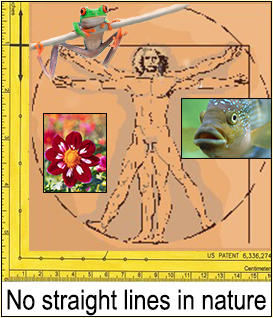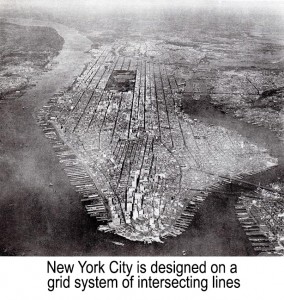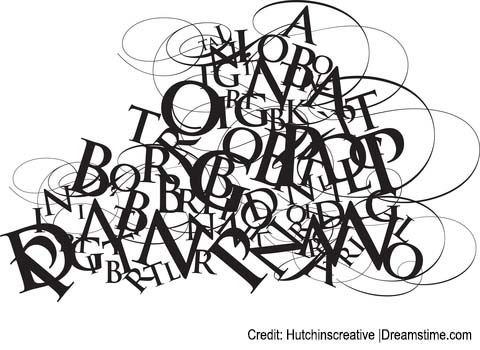Imagine a world in which there are no straight lines. It would be chaos, wouldn’t it? The words (and lines) on this blog would present themselves in a haphazard fashion (such as in the grpahic to the right) and you would not be able to discern my answer to the question I pose in the headline.
All manner of reading materials—newspapers, magazines, radio scripts, broadcast and cable television transmissions on your flat screen or Sony Trinitron television sets, a page on a web site, or signs or staffs on a page of music—would be impossible to interpret or understand. Architectural drawings and plans would be impossible to create. Buildings would be impossible to build—unless, of course, the building is round or geodesic in shape. However, even in these cases the drawings upon which these non-straight lines designs appear are rectangular in shape. In other words, there’s no escaping the straight line in our society, and by society I mean virtually everyone on the planet!
How did this come about? Why are all societies on this planet bound by the straight line? Why is it so prevalent? After all, when we look around at nature’s over-arching designs there are no straight lines to be seen. Well, not totally. One could argue that crystals inherently have a preponderance of straight lines in their structure, but overall the overwhelming shape of things in nature is not a straight line, or a  square, or a rectangle, or a polygon. The overwhelming shape in nature is a curve or something round or variations of something curved or round.
square, or a rectangle, or a polygon. The overwhelming shape in nature is a curve or something round or variations of something curved or round.
So, if as homo sapiens we are born out of nature—there are no straight lines in the human body either—why are we so obsessed with organizing things in straight lines? For example, up until about a century ago the straight line approach to military battles was primarily the norm. Trains run primarily in straight lines, as do many roads. Tunnels are basically straight from point to point. The shape of sheets of paper, newspapers and magazines consist of straight edges. In the 20th century, though, the plane had an impact of bending the straight line concept. Other than a runway, a plane does not travel purely in a straight line. Increasingly, in more recent times buildings have curves and angles, as opposed to straight up and down lines.
The answer, therefore, to the question posed in the title of this blog seems to lie in either logic or common sense. When we examine the images created by our ancestors tens of thousands years ago in cave drawings even a casual viewing leads to the conclusion that the structure of the images are not placed in a straight line. The images—of hunters and animals—are clear enough, but they do not apparently appear to tell a story in a chronological or straight line.
Jump forward now to Ancient Egypt and the development of hieroglyphics. It is immediately observable that the “picture images” are placed in a  sequence—in a straight line. Hieroglyphics led to the development of what we now recognize as “letters.” About 5,000 years ago in the area of the Mediterranean, the Sumerians developed early writing. One scholar—Denise Schmandt-Besserat, author of How Writing Came About (University of Texas Press, 1992)—surmises that early writing evolved through the use of so-called “tokens” because of the increase in trade among various cultures in that part of the world. In effect, early accountants are responsible for the development of writing. Later, in the neighborhood of 700BC, the ancient Greeks developed what we know as the “alphabet” upon which the writing system of western civilization is based.
sequence—in a straight line. Hieroglyphics led to the development of what we now recognize as “letters.” About 5,000 years ago in the area of the Mediterranean, the Sumerians developed early writing. One scholar—Denise Schmandt-Besserat, author of How Writing Came About (University of Texas Press, 1992)—surmises that early writing evolved through the use of so-called “tokens” because of the increase in trade among various cultures in that part of the world. In effect, early accountants are responsible for the development of writing. Later, in the neighborhood of 700BC, the ancient Greeks developed what we know as the “alphabet” upon which the writing system of western civilization is based.
Imagine if all this—and the civilization that evolved from these writing systems—were not based on a straight line! The fact is the straight line is inherent to the evolution of writing. In a direct way, the inherent function of the straight line grows (no pun intended) out of the evolution of early agriculture. At one time western writing systems went from left to right and then on the next line from right to left, and so on. It was called “the way of the ox,” a direct reference to how farming was done in ancient times.
Imagine a world without a straight line when it comes to mathematics. The earliest recorded beginnings of geometry, for example, can be traced to early peoples who discovered obtuse triangles in the ancient Indus Valley, and ancient Babylonia from around 3000 BC—about the same time as the evolution of writing systems as we understand it. Early geometry was a collection of empirically discovered principles concerning lengths, angles, areas, and volumes, which were developed to meet some practical need in surveying, construction, astronomy, and various crafts. Among these were some surprisingly sophisticated principles, and a modern mathematician might be hard put to derive some of them without the use of calculus. For example, both the Egyptians and the Babylonians were aware of versions of the Pythagorean theorem about 1500 years before Pythagoras; the Egyptians had a correct formula for the volume of a frustum of a square pyramid.
In a way, the development of the straight line that forms the basis for much of our civilization is in direct contradiction to what as human beings we see around us—the round sun, moon, the curvature of the  earth, the shape of flowers, leaves, tree trunks, faces, arms, legs, necks, mouths, the buttocks, a pregnant woman. The vast majority of our world is full of curves and roundness, not straight lines. Yet our civilization is built on the foundation of the straight line and has done so ever since the evolution of written language and mathematics about five thousand years ago! I’m just taking a good guess, but I’m willing to bet that before the evolution of writing systems and mathematics, when peoples—i.e., tribal cultures—communicated only by oral or aural means, the architecture of these cultures was round, not square or rectangular. You can see this in some non-literate tribes living today.
earth, the shape of flowers, leaves, tree trunks, faces, arms, legs, necks, mouths, the buttocks, a pregnant woman. The vast majority of our world is full of curves and roundness, not straight lines. Yet our civilization is built on the foundation of the straight line and has done so ever since the evolution of written language and mathematics about five thousand years ago! I’m just taking a good guess, but I’m willing to bet that before the evolution of writing systems and mathematics, when peoples—i.e., tribal cultures—communicated only by oral or aural means, the architecture of these cultures was round, not square or rectangular. You can see this in some non-literate tribes living today.
Regardless, the inescapable fact is that the straight line is fundamental to our culture, regardless of who first came up with the concept.
Please write to me at meiienterprises@aol.com if you have any comments on this or any other of my blogs.
Eugene Marlow, Ph.D.
October 7, 2013
© Eugene Marlow 2013


